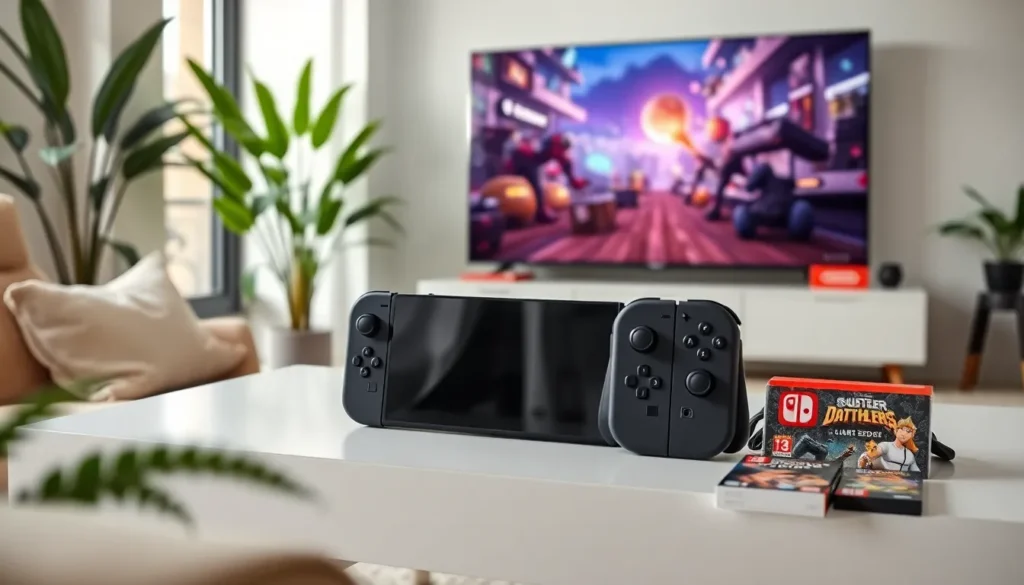Table of Contents
ToggleThe Nintendo Switch has taken the gaming world by storm, offering a blend of portable fun and home console excitement. But even the most magical devices can encounter hiccups—like when the screen freezes right before a boss battle or when the Joy-Con decides to play hide and seek. Panic not! Troubleshooting doesn’t have to feel like a quest for the Holy Grail.
Common Nintendo Switch Issues
Even the Nintendo Switch can face challenges. Two frequent problems involve connection issues and game performance.
Connection Problems
Connection problems occur when the Nintendo Switch struggles to connect to Wi-Fi networks. Users may notice weak signals or disconnects during online sessions. To fix these issues, first, check the router’s location. If the console is too far, move it closer to improve signal strength. Restarting the router can also help. Resetting the network settings within the console tends to resolve stubborn connectivity problems. Finally, users should ensure that the software is up to date, as firmware updates can enhance connectivity.
Game Performance Issues
Game performance issues often manifest as lag or frame drops during gameplay. These disruptions can be frustrating, especially in fast-paced titles. Players should start by closing background applications to free up resources. Clearing the cache on the console is another effective method. Checking for game updates may resolve bugs causing performance hiccups. Additionally, using a microSD card optimized for speed enhances loading times and overall experience. Adjusting the console’s resolution settings can yield smoother gameplay as well.
Basic Troubleshooting Steps

Basic troubleshooting can resolve many common Nintendo Switch issues. Following these steps may enhance performance and connectivity.
Restarting Your Console
Restarting the Nintendo Switch often solves minor glitches. Turn off the console by holding the power button for three seconds and selecting “Power Options.” After selecting “Restart,” the device shuts down completely and restarts automatically. This process clears temporary data and can improve system stability. If the device remains unresponsive, holding the power button for at least 12 seconds forces a shutdown. Once fully powered off, waiting a moment before turning it back on can make a significant difference.
Checking for Updates
Checking for software updates ensures the Nintendo Switch is up to date. Navigate to the “System Settings” and select “System.” Under this menu, the “System Update” option confirms whether the console has the latest software. If an update is available, the system will begin downloading immediately. Installing updates can fix known bugs and enhance overall performance. Staying updated prevents compatibility issues with new games and features, ensuring a smoother gaming experience.
Advanced Troubleshooting Techniques
Advanced troubleshooting techniques offer deeper solutions for persistent Nintendo Switch issues. These methods address more complex problems not resolved by basic steps.
Resetting the Console
Resetting the console can resolve various issues like game crashes or persistent error messages. To perform a soft reset, press and hold the Power button for approximately 10 seconds until it shuts down. Restarting it restores system functions. A harder option is the factory reset, which removes all data. To initiate, navigate to System Settings, select System, and then choose Formatting Options. Confirm the factory reset to erase all data. Backup saved data before proceeding, as this process is irreversible.
Safe Mode Options
Safe Mode provides advanced recovery options if the console experiences severe issues. To enter Safe Mode, turn off the Nintendo Switch, then hold the Volume Up and Volume Down buttons while pressing the Power button. Options in Safe Mode include system updates, cache clearing, and factory resets. Users have the ability to update the console without connectivity in some cases. Clearing the cache boosts performance by removing corrupted data. This mode often resolves major glitches that other methods can’t fix.
When to Seek Professional Help
Seeking professional assistance becomes essential when basic and advanced troubleshooting methods fail to resolve issues with the Nintendo Switch. Persistent hardware problems, such as unresponsive buttons or a malfunctioning touchscreen, may indicate a need for expert diagnostics. Users should consider professional help if the console displays critical error messages that prevent gameplay entirely.
Frequent crashes during gameplay can signal underlying hardware malfunctions. If a user continuously faces these disruptions after attempting various solutions, contacting Nintendo support is advisable. Repair options may include hardware replacement, which is often best handled by certified technicians.
Consulting professionals also applies to issues resulting from water damage or physical impacts. Visible signs of damage can worsen over time, leading to more significant failures. In such cases, attempting DIY fixes can result in unintended complications.
For individuals unfamiliar with electronics repairs, they should avoid disassembling the device. Doing so might void warranties, making professional evaluation a safer choice. Warranty-related concerns also come into play for newer consoles. If the device remains under warranty, seeking support ensures potential repairs are covered without additional costs.
Lastly, if significant software glitches occur even after a factory reset, professional expertise becomes crucial. Technical support from Nintendo can provide tailored solutions that are otherwise elusive. Prioritizing professional assistance can prevent frustration and ensure the console returns to optimal functioning.
Troubleshooting the Nintendo Switch can seem overwhelming but it doesn’t have to be. By following the outlined steps users can resolve many common issues effectively. Whether it’s connection problems or game performance hiccups a few simple adjustments can often restore functionality.
For more persistent challenges advanced techniques like resetting the console or utilizing Safe Mode can provide further solutions. However if problems continue after trying these methods seeking professional help is essential. Recognizing when to consult an expert can save time and ensure the console is repaired properly.
With the right approach most users can enjoy a seamless gaming experience on their Nintendo Switch.




